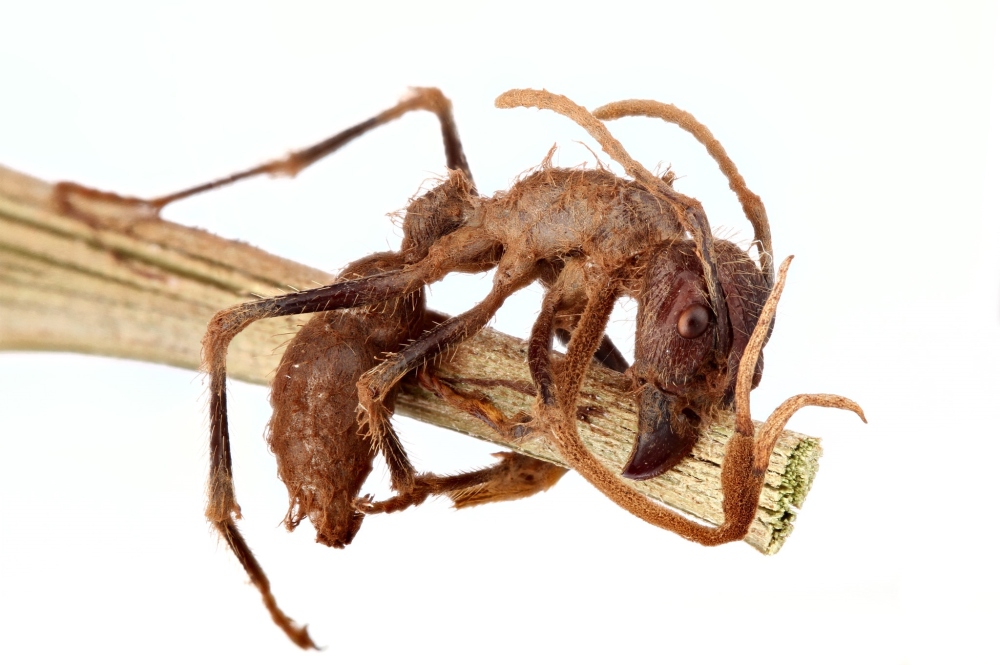Zombies have long captured people’s imaginations, and since they are a huge part of popular culture, we definitely love daydreaming about scenarios where the world is facing a zombie apocalypse. Luckily, these mindless creatures are only the products of our imagination, or aren’t they?
What if we told you that zombies are real and that they can be found in nature?

A real-life zombie ant. Image credits: Bernard DUPONT/Wiki Commons
The horrifying phenomenon in question is caused by a parasitic fungus called Ophiocordyceps unilateralis. It infects its prey and grows through its body, consuming it and taking over its mind, forcing it to an elevation where the spores can later spread to the cordyceps‘ next victim.
You do not need to worry about getting infected by the zombie fungus, though. First of all, its natural habitat is generally in tropical rainforests and jungles, so it’s nearly impossible to come across it in our modern living environment. Also, humans are not the target of this sinister parasite, since our bodies are way too large for it to infect. Interestingly enough, cordyceps are well known in Traditional Chinese Medicine, and they’ve been using it to treat fatigue, sickness, and kidney diseases. Its potential health effects are indeed very promising, but research on their effects on humans is very limited; therefore it would be too early to draw any conclusions.
Insects, most typically the ants of the jungles, however, will definitely not benefit from these health effects. In fact, they are the most suitable prey for cordyceps.

While ants are the most likely to fall victim to cordyceps, other insects are in danger as well. Image credit: Frupus
Maridel A. Fredericksen, who closely studied cordyceps in ants, found that when the spore infiltrates the body of an ant, it only exists as a multitude of cells that float around in the host’s bloodstream, also replicating in the process. After a while, these cells start working together, as they start connecting to each other by building small tubes. This way, they can communicate and exchange nutrients with each other. These fungal networks will start surrounding the muscles, penetrating the muscle cells and growing into the spaces between them.
As the fungus infection spreads, the host is compelled to head for a more humid microclimate, which is more favorable to the fungus’s growth, usually about 10 inches above the ground. Yet, the cordyceps doesn’t seem to achieve this type of mind-control through its victim’s brain. It interferes with the nervous system of its host and controls it directly at the muscles, leaving the brain untouched.
So basically what happens is that the growing fungus cuts the ant’s control over its limbs and releases chemicals that force the muscles to contract.

A “zombie” bullet ant as it clamped onto a plant. Image credits: James Marchment/Insects Unlocked
Once the disoriented host has reached the desired vantage point, the fungus growing inside forces its victim to clamp down with its mandibles around a leaf, which then dies in this same position. At the same time, the fungus keeps feeding off the insides of its host, getting ready for the final stage.
Days after the host is dead, the cordyceps starts erupting out of its body, revealing itself. The fruiting stalks grow into bulbous capsules that are full of spores – a sight that truly appears to be from a horror movie. After weeks of growing, the cordyceps will release its spores to infect other insects, starting a new life cycle.
Infected ants usually clamp on a leaf above their colony, so the fungal spores can rain down onto its nest below, putting the whole colony in serious danger. Therefore, as seen in David Attenborough’s Planet Earth, if the workers find members of the colony who are affected by contracting cordyceps, they quickly take them away and dump their bodies far away from the colony.

This ant infected with Ophiocordyceps unilateralis has ventured to a vantage point where the fungus can spread more easily. Image credit: Penn State
What we’re witnessing here is a seemingly malevolent, yet incredibly stunning, natural phenomenon that nevertheless does not pose any danger to humans, as noted above. That said, we can have a pretty good guess what it would look like if it could infect us somehow, as this fungus was the main inspiration behind the zombies in the highly successful video game series, The Last of Us.
For now, though, it’s only just science-fiction; since its discovery in 1859, we have identified more than 400 different species of cordyceps all around the world, and needless to say, none of them even cared to come close to us – in the form of a zombie ant, for example.
Sources: 1, 2, 3, 4








